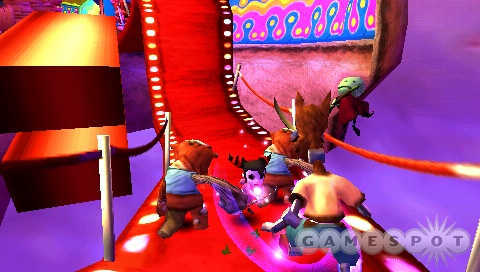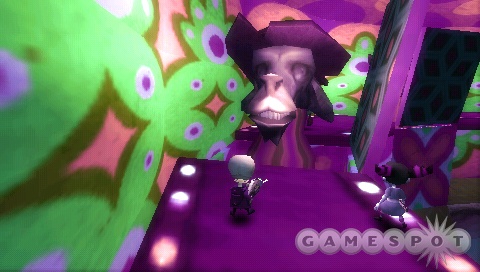The original Death Jr. received quite a bit of attention because it was one of the first PlayStation Portable games shown in video form. Its impressive 3D graphics gave consumers their first glimpse into the capabilities of the PSP. Unfortunately, when it was finally released, Death Jr. didn't live up to the hype. Just over a year later, the follow-up, Death Jr. II: Root of Evil, has been released, and it shares many of its predecessor's problems. The great characters and mostly interesting level design are no match for the lousy camera placement, frustrating controls, and shallow story.

It's puzzling that both Death Jr. games have hardly any story in them, yet there's a comic book series based on the characters. The game opens with Death Sr. being captured by a raging Hulk-like female creature named Furi, who is trying to take over the world. It's then revealed that Death Jr. and his girlfriend, Pandora, were responsible for releasing Furi when they accidentally broke her cocoon open while trying to complete a science project. The duo is unaware that Death Sr. has been captured, but they do know they're responsible for the sudden changes to their world; so, with the help of their wacky bunch of friends, they set off to right their wrong.
But the story is weak. The likable characters are underutilized, as is the game's great sense of humor. There are a few laugh-out-loud moments, but with wacky characters like the Seep (a limbless fetus-type thing in a formaldehyde container) and a dead fish named Dead Guppy, there was potential for much more.
When the game begins, you can choose whether you want to play as Death Jr. or Pandora. Once you've started, you won't be able to switch characters--you have to play with the same character all the way through. Other than a few of the cutscenes relating to Death Jr. being removed when playing as Pandora, their adventures are identical. A new feature this time around is co-op play. If you've got a friend with a copy of the game you can play through the entire adventure cooperatively. But the co-op version of the game is exactly the same as the single-player experience--and there aren't actually any instances where cooperation is required (though it can be nice to have some help killing the game's many bad guys). It's disappointing that you're unable to load a saved single-player game and play it with a friend--you'll have to start a new game.
Despite the fact that each character is touted as having its own weapons and moves, both Death Jr. and Pandora play almost exactly the same. Death Jr. is once again armed with a scythe, which he'll use to pummel enemies and grab hooks. He can also spin his weapon rapidly over his head to glide gracefully through the air. Pandora uses her whip in the same way. At first their attacks are limited, but DJ (as his friends call him) and Pandora can use energy orbs they get from fallen enemies to purchase new moves. Both characters can use guns to perform ranged attacks. Hidden throughout each level are parts that can be used to build new guns or upgrade existing weapons.

Death Jr. II: Root of Evil is an action-platformer, so you'll do plenty of running, jumping, and shooting. Both characters can use their weapons to swing from hooks, and they can even grab on to vines and use them as zip lines. It's confusing that grabbing on to hooks requires one set of button presses, while doing almost the exact same thing on a horizontal pole involves a different combination. Sliding on vines is a piece of cake most of the time, until the game randomly decides to not require you to hit the square button to latch on to the vine--resulting in numerous deaths until you figure out what's going on. Most of the game's challenge comes not so much from creative level design (though there are some cool areas), but more from it being so difficult to manage the controls and camera at the same time. You can pan the camera with the shoulder buttons, and while this is a more manageable solution than in the first game, it's still tough to do when you're on the move, and sometimes you just can't get the camera where you want.
There are plenty of platforming elements, to be sure, but Death Jr. II's primary gameplay focus is on combat. You'll fight hundreds upon hundreds of creatures, from psychotic toys and clowns to overgrown plants and crazed chickens that shoot lasers. Swinging your scythe like a madman is entertaining for a few levels, but despite the impressive variety of enemies there are to kill, the combat quickly grows old thanks to enemies that spawn from thin air, and it's maddening to be constantly under a barrage of lasers and bombs that come from enemies just off camera. You can purchase new attacks by trading in energy orbs, but because the new moves are mostly just variations of hitting and holding the attack button, it seems as though pulling off a specific move is more a result of luck than of skillful play.
Many of the gun upgrades are similarly useless. Some of them are weak and difficult to aim, and there's really not much incentive to look for more weapon parts once you've bought and upgraded the rocket launcher, since it gets the job done in any situation. There's an auto-aim feature, but it's poorly implemented as there's no way to easily switch from one target to another. It's possible to manually aim your weapon; however, the controls are so clunky you'll generally end up blown to bits by enemy fire before you line up your target. Just swinging your scythe can result in instant death if you're too close to the edge of a cliff, because your momentum carries you forward every time you swing. Nothing's more frustrating than trying to fend off a horde of enemies and then plunging to your death courtesy of the unfriendly controls. Early on in the game the platforming segments aren't too difficult and there are plenty of checkpoints to keep you from having to replay large segments of a level over should you die. But the game is downright ruthless near the end thanks to fewer checkpoints as well as the prevalence of lava, which results in instant death if you come into contact with it.
Root of Evil's graphics are mostly great, marred only by the troublesome camera, a few unsightly textures, and a couple of bland levels. The occasional boring area is an exception to the rule, as the majority of the levels are creatively designed and have interesting themes. The World of Waffles level, with its bright colors, crazy circus themes, and larger-than-life pinball machine area, is particularly noteworthy. Most impressive, though, are the game's lighting and particle effects that constantly light up the screen with an array of fire, sparks, and explosions. The frame rate always remains steady, no matter how many enemies and explosions are onscreen at once.

Death Jr. II's audio is also quite good. There aren't any big names voicing the characters, but the voice work is easily as good or better than a typical Saturday-morning cartoon. Unfortunately, you don't get to hear enough of the great voices. Outside of an occasional quick bit of dialogue during a level, the characters speak only during the brief and all-too-infrequent cutscenes. Sound effects are decent, but there's not much variety to them. Death Jr.'s screams and wails are particularly grating on the nerves. The soundtrack has a couple of standout tunes, but most of the time it takes a backseat to explosions, screams, and gunfire.
In spite of the gameplay being riddled with annoying problems, Death Jr. II has its share of fun moments. On the rare occasion when the controls and the camera work in harmony, you'll have a good time running, swinging, and shooting your way through the levels. Even combat is sometimes fun, provided you're not near a cliff, and as long as there are only a few bad guys around and they're not flying or shooting anything at you. It's during these few moments of joy that you wonder why the whole game isn't that way. The potential for an enjoyable game exists, but Backbone has once again been unable to capitalize on it. If you managed to find a way to enjoy the first Death Jr. game, you'll probably be able to do the same with the sequel--but unless you consider yourself extremely patient, you'll want to stay away.